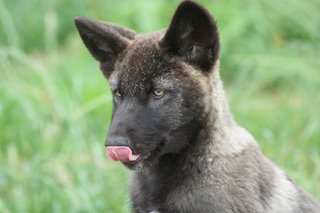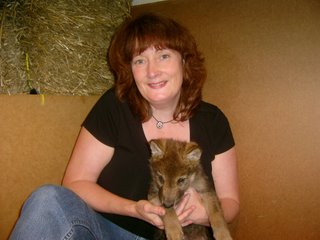 Deep in Russia’s southern taiga, north west of Moscow, lies Chisty Les (Clean Forest) Biological Station, a project that was started some 25 years ago by Valentin Pazetnov and Viktor Bologov, who were interested in the conservation of bears and wolves.
Deep in Russia’s southern taiga, north west of Moscow, lies Chisty Les (Clean Forest) Biological Station, a project that was started some 25 years ago by Valentin Pazetnov and Viktor Bologov, who were interested in the conservation of bears and wolves.Chisty Les is now run by three generations of these two dedicated families, plus scores of volunteers and other project staff. Vladimir Bologov followed his father into wolf conservation and now spends all of his time on research, education and capacity building.
My colleagues, Chris Senior and Alex Hampson, and I visited Chisty Les in August and stayed with Vladimir and his family in Bubonitsy v illage. The white knuckle taxi-drive from Moscow took us over six hours, the majority of which was through birch and pine forest, which lined the road on either side. The immensity and scale of the forest put a whole new perspective on some of the old fairy-stories like Hansel and Gretel. The latter part of the journey was on undulating and potholed dirt roads, and it was a relief to get off the main highway, which was fraught with danger. We saw lots of risky overtaking, at least three accidents, and far too many posts adorned with floral tributes for victims of this nightmare road. (The overnight train definitely seems the better option next time we go over there.)
Having arrived in one piece, we were warmly greeted b y Vladimir and his wife, Natasha, and their two eco-volunteers from Holland, Petter and Bettina, who were working at the project for three weeks
The next morning we set off to visit the rest of the Biological Station, which is spread over three sites. Our first stop was to see the film crew who are working on a series of documentaries for the project. This professional team, from Moscow Television, were keen to show us the two short videos they have produced on wolves and bears, and we spent a delightful morning viewing these before heading off for a walk to the lake.
The lake is an integral part of Chisty Les, and it is here that the Eco Summer Schools have been held for children. There are a couple of wooden buildings by the lake, and the children camp out for two weeks and learn about the ecology of Russia, and associated conservation issues.
 A new Education Centre has also just been completed at Chisty Les, which is three storeys high and built in traditional Russian log frame style. This impressive building will be officially opened in early 2007, but was already hosting small conferences and workshops, with a conference being held later that week for 60 bear biologists from all over Russia.
A new Education Centre has also just been completed at Chisty Les, which is three storeys high and built in traditional Russian log frame style. This impressive building will be officially opened in early 2007, but was already hosting small conferences and workshops, with a conference being held later that week for 60 bear biologists from all over Russia.The next village we visited was also part of the Biological Station. It was an old abandoned village, and Vladimir has bought many of the houses so they can be used for accommodation for research students and volunteers. Here we met Laetitia who is a student from France. She originally came to the project for two weeks, and then again for two months, and is now staying for three years – such is the nature of Chisty Les, it captures the heart, soul and imagination; and other volunteers we spoke to had also previously stayed at the project.
Many parts of rural Russia are economically poor and even more so since the collapse of the socialist regime. This village had been abandoned as people left to find work in the towns and cities. Visiting in the summer months was a pleasure (apart from catching the tail-end of the mosquito season, but you could easily see how hard it would be to survive a harsh winter here. The small wooden houses have no bathroom facilities (although Vladimir is now working to get this remedied), and no piped water. Even in summer, we could feel the remoteness of the place and how cut off we were from civilisation. There was no mobile telephone signal, and the landline connections are intermittent. Whilst this is enjoyable in the short term for those of us seeking the escape from the frantic pace of technological life in Western Europe, it could be difficult if you were staying longer.
Approximately 700 metres away from the house, in the forest, there is a wolf enclosure, covering 2.5 acres of land. During our visit, this was home to four juvenile wolves who had been purchased from hunters with the help of a donation from the UKWCT. The wolves were being raised in captivity, with the minimum amount of human contact, with the aim of releasing them back into the wild. Chisty Les has already had success in raising and releasing over 120 bear cubs, but until recently hadn’t attempted this with wolves.
The next morning Vladimir received telephone calls from two villages in the region. One village had reported numerous sightings of a white wolf in the village, and the other had sustained a wolf attack, with one sheep being killed and two others injured.
Whilst speeding into action like some crack wolf-response team, the 4x4 decided it had had enough, started making funny rattling noises, and then gave up altogether. The problem was a broken distributor cap. A piece had broken off. The broken piece was still there, fortunately, so all we needed was the means to reattach it. An impossible task one might think, when stuck out in the middle of nowhere. We tried standing around staring at the engine – the universal human response? – but found that some superglue from a passing motorist, who had stopped to help, was more useful in getting us on our way again.
We arrived at the first village and drove around for a while before stopping at one of the houses. The owner came out to greet us, followed closely by his children. A lengthy conversation took place, and later Vladimir relayed to us that a white wolf had been seen by a number of villagers. Although very unusual, there have been previous reports of a white wolf in the region.
 Our next visit was more fruitful. We were shown the two sheep which had survived a wolf attack, before being shown around the property, which was basically a house with land and outbuildings attached. Livestock in these situations is usually kept in a barn or outbuilding overnight, to keep it safe from predators. Most villagers also have at least one dog, generally chained up outside. Predation on dogs is a huge problem in rural areas, and Vladimir is working hard to convince people that part of this problem is the fact that keeping them chained up outdoors makes them an easy meal for wolves.
Our next visit was more fruitful. We were shown the two sheep which had survived a wolf attack, before being shown around the property, which was basically a house with land and outbuildings attached. Livestock in these situations is usually kept in a barn or outbuilding overnight, to keep it safe from predators. Most villagers also have at least one dog, generally chained up outside. Predation on dogs is a huge problem in rural areas, and Vladimir is working hard to convince people that part of this problem is the fact that keeping them chained up outdoors makes them an easy meal for wolves.On looking around the property, we could see that the forest line came to within ten metres of the house. This would give wolves good cover for making such attacks, and is something that needs to be addressed with the villagers. We spent some time talking to the villager who had lost the sheep, and he reported that this was the first attack they had had in over 25 years. Apparently the barn door had been left open in the night and the wolves had taken their opportunity. Vladimir will now work with the villagers to try deter the wolves from entering the village, using aversive conditioning techniques: Wolves are naturally wary creatures, and even simple methods such as putting brightly coloured balloons along a fence have been shown to work. Despite all this, the villager was not upset or angry, but merely showed a pragmatic concern as to what he should have done differently to prevent the attack. And this despite it being one of only seven sheep he was looking after – some for the local ranger. This attitude of one man losing a seventh of his flock – animals needed as food through the winter – is markedly different to the livestock growers of the USA – with herds thousands strong and often grazing on public lands – the majority of whom would like to see the wolf eradicated again, claiming that it threatens their livelihood.
 The battle for wolf conservation in Russia is an uphill one. There is still a bounty on each wolf killed, and any method of killing a wolf can be used, including poison, which is banned in every other country except Russia, although this method is no longer widespread. The wolf population density around Chisty Les is high, and I have learned since returning from our visit that hunters killed 12 wolves in the area while we were there. One particular hunt killed a mother and six pups. Hunting is still a popular tradition, and even a cursory search on the internet will produce a list of companies that take hunting parties out to Russia.
The battle for wolf conservation in Russia is an uphill one. There is still a bounty on each wolf killed, and any method of killing a wolf can be used, including poison, which is banned in every other country except Russia, although this method is no longer widespread. The wolf population density around Chisty Les is high, and I have learned since returning from our visit that hunters killed 12 wolves in the area while we were there. One particular hunt killed a mother and six pups. Hunting is still a popular tradition, and even a cursory search on the internet will produce a list of companies that take hunting parties out to Russia.Despite such adversity, there have been some notable successes: The project has managed to negotiate approval for a protected area of 12,000 hectares around the station; they have just completed an impressive three-storey, traditionally built Education Centre, which hosted a bear conference for over 60 experts from all over Russia while we were there; the Ecological Summer School programme, which has been held at the Station for the past couple of years, is going from strength to strength; a film crew from Moscow television has volunteered their skills and experience to produce 12 documentary films for the project in order to raise awareness about the conservation of bears and wolves to a global audience; and, more importantly, there is some headway being made in changing attitudes: Vladimir and his colleagues have already converted some hunters to helping the project, and rather than going out shooting or trapping wolves to kill them, they are now helping to radio collar t hem and protect them.
Photo credits : Chris Senior (www.pbase.com/pawsforthought), and Chisty Les Biological Station (www.russianwolves.org).
You will find more photos from our visits to Bulgaria and Russia on Chris's site at pbase.com

